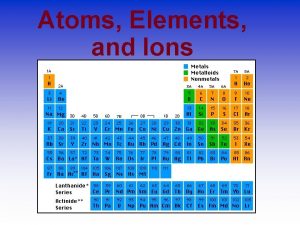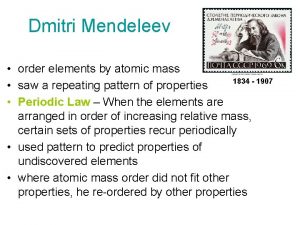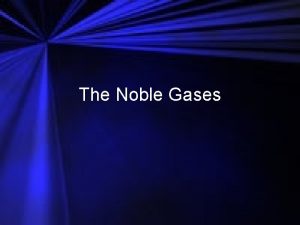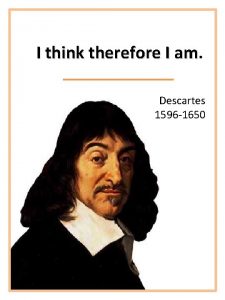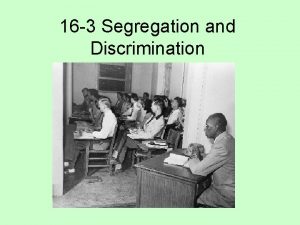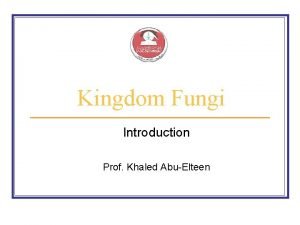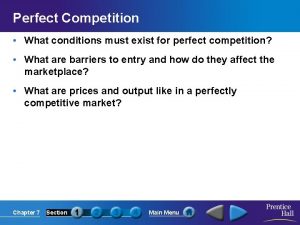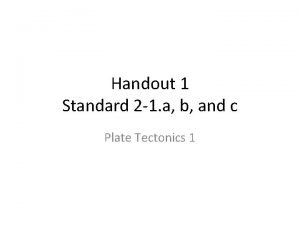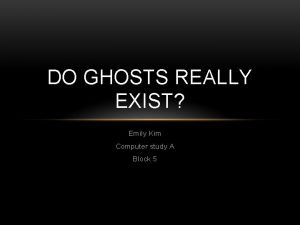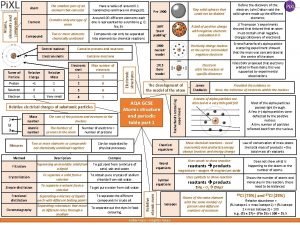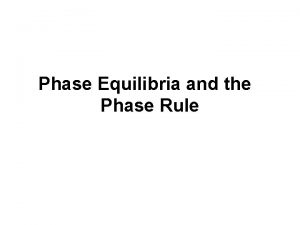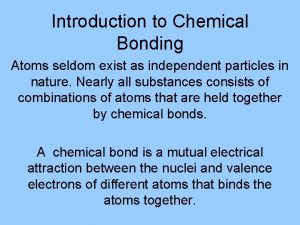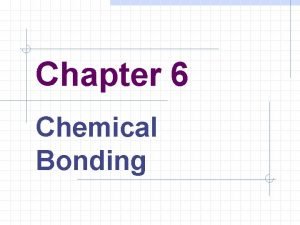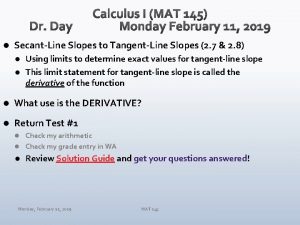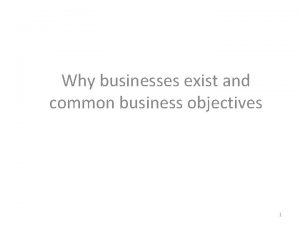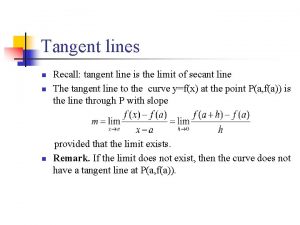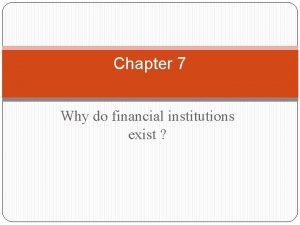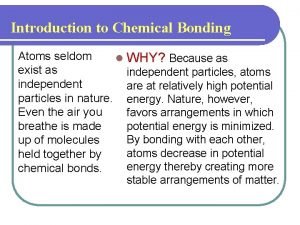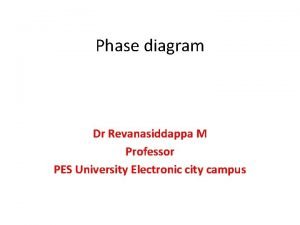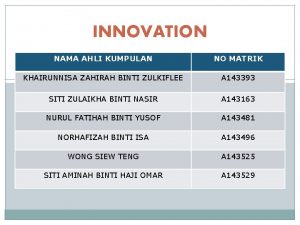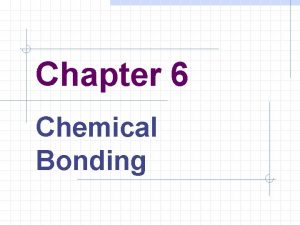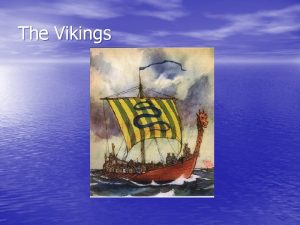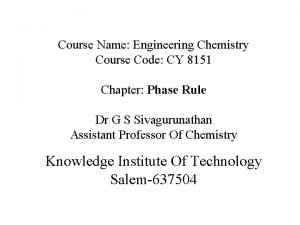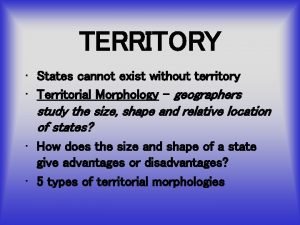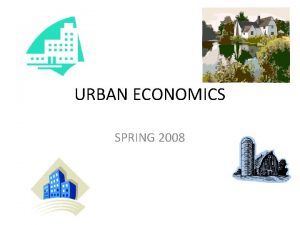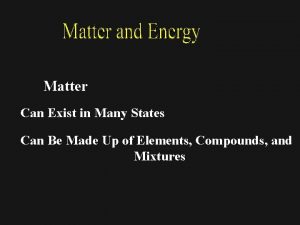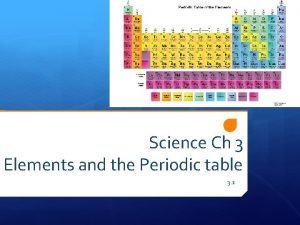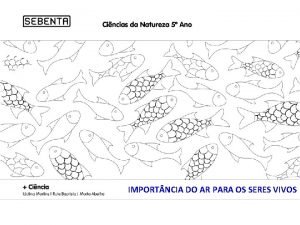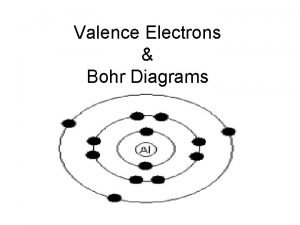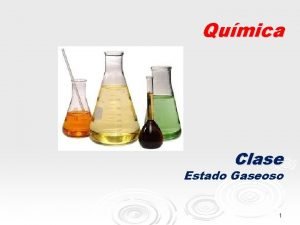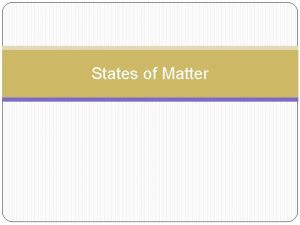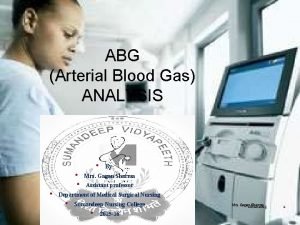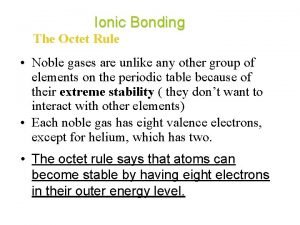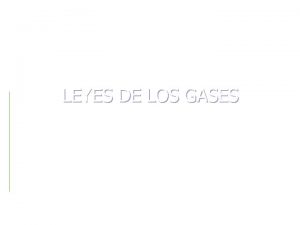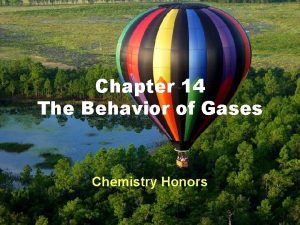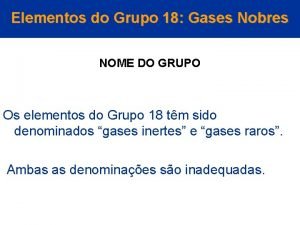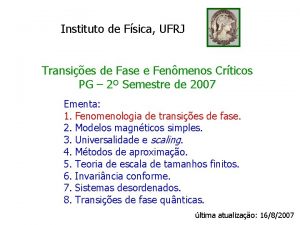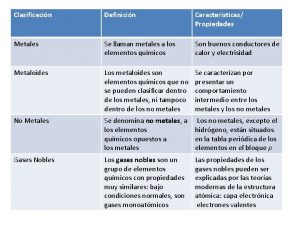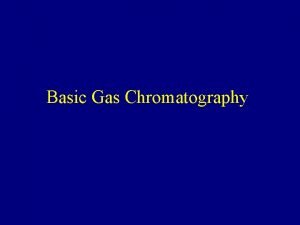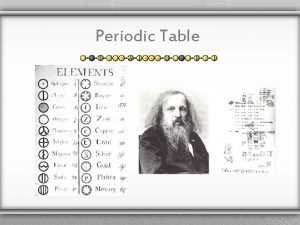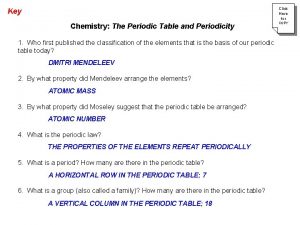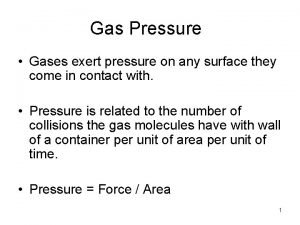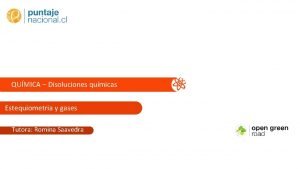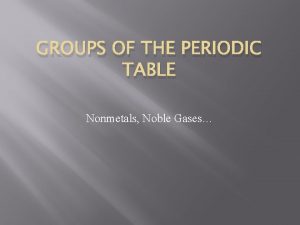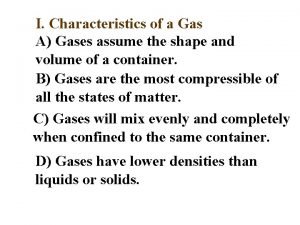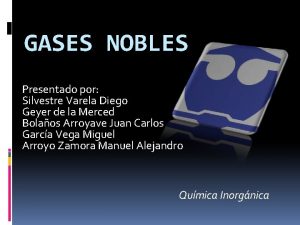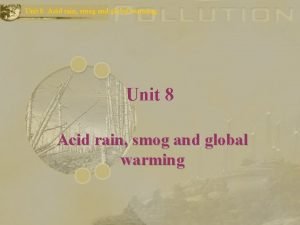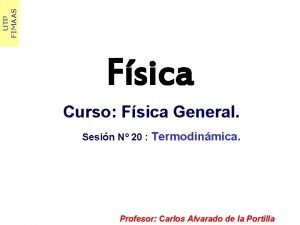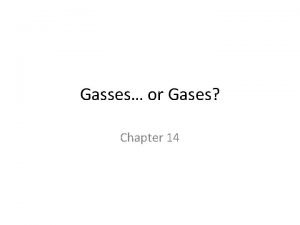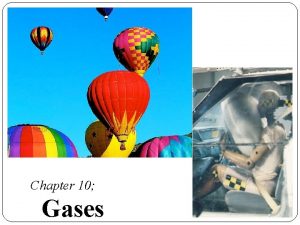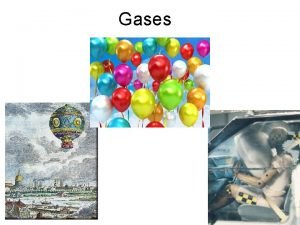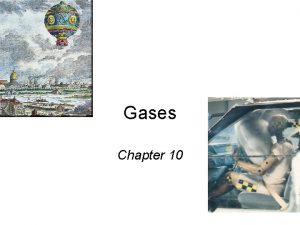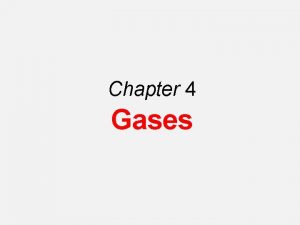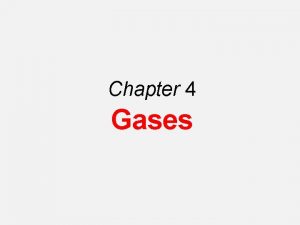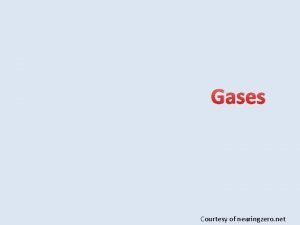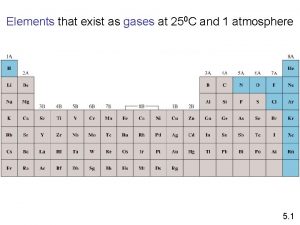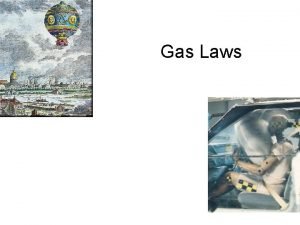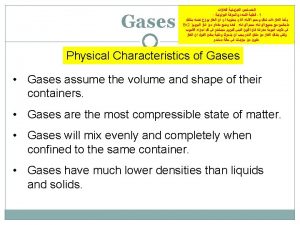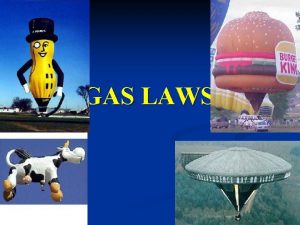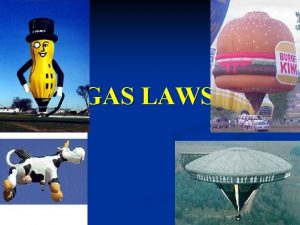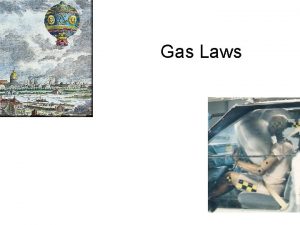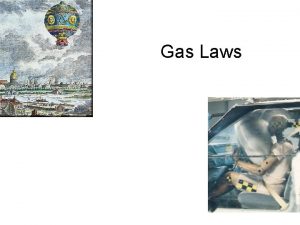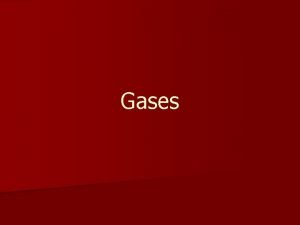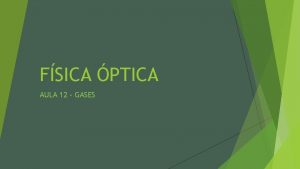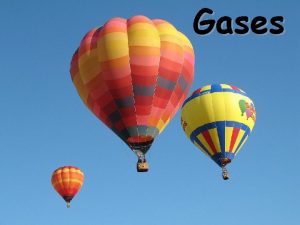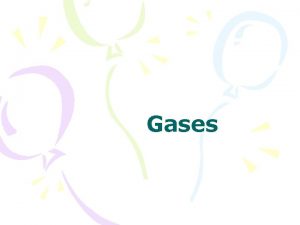Gases 1 Elements that exist as gases at

























































































- Slides: 89

Gases 1

Elements that exist as gases at 250 C and 1 atmosphere 2

Physical Characteristics of Gases • Gases assume the volume and shape of their containers. • Gases are the most compressible state of matter. • Gases will mix evenly and completely when confined to the same container. • Gases have much lower densities than liquids and solids. NO 2 gas 3

Kinetic Molecular Theory • Particles in an IDEAL gas (lies)… – have no volume. – don’t attract or repel each other. Truths – are in constant, random, straight-line motion – have an avg. KE directly related to Kelvin temperature.

Real Gases • Particles in a REAL gas… – have their own volume – attract each other • Gas behavior is most ideal… – at low pressures – at high temperatures – in nonpolar atoms/molecules

Characteristics of Gases • Gases expand to fill any container. – random motion, no attraction • Gases are fluids (like liquids). – no attraction • Gases have very low densities. – no volume = lots of empty space

Characteristics of Gases • Gases can be compressed. – no volume (ideally) = lots of empty space • Gases undergo diffusion & effusion. – random motion

Temperature • Always use absolute temperature (Kelvin) when working with gases. ºF -459 ºC -273 K 0 32 212 0 100 273 373 K = ºC + 273

Force Pressure = Area (force = mass x acceleration) Units of Pressure 1 pascal (Pa) = 1 N/m 2 1 atm = 760 mm. Hg = 760 torr 1 atm = 101, 325 Pa 9

10 miles 4 miles Sea level 0. 2 atm 0. 5 atm 10

Pressure • KEY UNITS AT SEA LEVEL 101. 325 k. Pa (kilopascal) 1 atm 760 mm Hg 760 torr 14. 7 psi

STP Standard Temperature & Pressure 0°C 1 atm -OR- 273 K 101. 325 k. Pa

Example The pressure outside a jet plane flying at high altitude falls considerably below standard atmospheric pressure. Therefore, the air inside the cabin must be pressurized to protect the passengers. What is the pressure in atmospheres in the cabin if the barometer reading is 688 mm. Hg?

Example Strategy Because 1 atm = 760 mm. Hg, the following conversion factor is needed to obtain the pressure in atmospheres: Solution The pressure in the cabin is given by

Manometers Used to Measure Gas Pressures closed-tube open-tube 15

Apparatus for Studying the Relationship Between Pressure and Volume of a Gas As P (h) increases V decreases 16

BOYLES LAW 17

Boyle’s Law P a 1/V 18

Boyle’s Law PV = k P V

CHARLES LAW 20

Variation in Gas Volume with Temperature at Constant Pressure As T increases V increases 21

Charles’ Law V T

Variation of Gas Volume with Temperature at Constant Pressure Charles’s & Gay-Lussac’s Law Va. T V = constant x T Temperature must be in Kelvin V 1/T 1 = V 2 /T 2 T (K) = t (0 C) + 273. 15 23

Gas Law Problems • A gas occupies 473 cm 3 at 36°C. Find its volume at 94°C. CHARLES’ LAW GIVEN: T V V 1 = 473 cm 3 T 1 = 36°C = 309 K V 2 = ? T 2 = 94°C = 367 K WORK: P 1 V 1 T 2 = P 2 V 2 T 1 (473 cm 3)(367 K)=V 2(309 K) V 2 = 562 cm 3

Avogadro’s Law V a number of moles (n) V = constant x n Constant temperature Constant pressure V 1 / n 1 = V 2 / n 2 25

Avogadro’s Principle V n

Summary of Gas Laws Boyle’s Law 27

Charles’s Law 28

Avogadro’s Law 29

Ideal Gas Equation Boyle’s law: P a 1 (at constant n and T) V Charles’s law: V a T (at constant n and P) Avogadro’s law: V a n (at constant P and T) Va n. T P n. T V = constant x =R P P R is the gas constant PV = n. RT 30

Ideal Gas Law V PV k =R n n. T T UNIVERSAL GAS CONSTANT R=0. 0821 L atm/mol K 3 R=8. 315 dm k. Pa/mol K

The conditions 0 0 C and 1 atm are called standard temperature and pressure (STP). Experiments show that at STP, 1 mole of an ideal gas occupies 22. 414 L. PV = n. RT (1 atm)(22. 414 L) PV R= = n. T (1 mol)(273. 15 K) R = 0. 082057 L • atm / (mol • K) 32

Ideal Gas Law • Calculate the pressure in atmospheres of 0. 412 mol of He at 16°C & occupying 3. 25 L. GIVEN: WORK: P = ? atm PV = n. RT n = 0. 412 mol P(3. 25)=(0. 412)(0. 0821)(289) mol L atm/mol K T = 16°C = 289 K K L V = 3. 25 L P = 3. 01 atm R= 0. 0821 L atm/mol K

Example Sulfur hexafluoride (SF 6) is a colorless and odorless gas. Due to its lack of chemical reactivity, it is used as an insulator in electronic equipment. Calculate the pressure (in atm) exerted by 1. 82 moles of the gas in a steel vessel of volume 5. 43 L at 69. 5°C. SF 6

Example Solution Because no changes gas properties occur, we can PV =inn. RT use the ideal gas equation to calculate the pressure. Rearranging Equation (5. 8), we write

Example Calculate the volume (in L) occupied by 7. 40 g of NH 3 at STP. NH 3

Example Strategy What is the volume of one mole of an ideal gas at STP? How many moles are there in 7. 40 g of NH 3? Solution Recognizing that 1 mole of an ideal gas occupies 22. 41 L at STP and using the molar mass of NH 3 (17. 03 g), we write the sequence of conversions as

Example So the volume of NH 3 is given by It is often true in chemistry, particularly in gas-law calculations, that a problem can be solved in more than one way. Here the problem can also be solved by first converting 7. 40 g of NH 3 to number of moles of NH 3, and then applying the ideal gas equation (V = n. RT/P). Try it. Check Because 7. 40 g of NH 3 is smaller than its molar mass, its volume at STP should be smaller than 22. 41 L. Therefore, the answer is reasonable.

Example A small bubble rises from the bottom of a lake, where the temperature and pressure are 8°C and 6. 4 atm, to the water’s surface, where the temperature is 25°C and the pressure is 1. 0 atm. Calculate the final volume (in m. L) of the bubble if its initial volume was 2. 1 m. L.

Example Strategy In solving this kind of problem, where a lot of information is given, it is sometimes helpful to make a sketch of the situation, as shown here: What temperature unit should be used in the calculation?

Example Solution According to Equation (5. 9) We assume that the amount of air in the bubble remains constant, that is, n 1 = n 2 so that which is Equation (5. 10).

Example The given information is summarized: Initial Conditions P 1 = 6. 4 atm V 1 = 2. 1 m. L T 1 = (8 + 273) K = 281 K Rearranging Equation (5. 10) gives Final Conditions P 2 = 1. 0 atm V 2 = ? T 2 = (25 + 273) K = 298 K

Example Check We see that the final volume involves multiplying the initial volume by a ratio of pressures (P 1/P 2) and a ratio of temperatures (T 2/T 1). Recall that volume is inversely proportional to pressure, and volume is directly proportional to temperature. Because the pressure decreases and temperature increases as the bubble rises, we expect the bubble’s volume to increase. In fact, here the change in pressure plays a greater role in the volume change.

AExample. D a l t o n ’ • The total pressure of a mixture of gases equals the sum of the partial pressures of the individual gases. Ptotal = P 1 + P 2 +. . . Patm = PH 2 + PH 2 O

AExample. • Hydrogen gas is collected over water at 22. 5°C. Find the pressure of the dry gas if the atmospheric pressure is 94. 4 k. Pa. D The total pressure in the collection bottle is equal to atmospheric pressure and is a mixture of H and water vapor. a WORK: l GIVEN: PH 2 = ? Ptotal = PH 2 + PH 2 O t Ptotal = 94. 4 k. Pa = PH 2 + 2. 72 k. Pa o. P = 2. 72 k. Pa H 2 O PH 2 = 91. 7 k. Pa n Look up water-vapor pressure Sig Figs: Round to least number on p. 899 for 22. 5°C. of decimal places. ’ 2

Example • A gas is collected over water at a temp of 35. 0°C when the barometric pressure is 742. 0 torr. What is the partial pressure of the dry gas? The total pressure in the collection bottle is equal to barometric pressure and is a mixture of the “gas” and water vapor. DALTON’S LAW GIVEN: Pgas = ? Ptotal = 742. 0 torr PH 2 O = 42. 2 torr Look up water-vapor pressure on p. 899 for 35. 0°C. WORK: Ptotal = Pgas + PH 2 O 742. 0 torr = PH 2 + 42. 2 torr Pgas = 699. 8 torr Sig Figs: Round to least number of decimal places.

Density (d) Calculations PM m d= = V RT m is the mass of the gas in g M is the molar mass of the gas Molar Mass (M ) of a Gaseous Substance d. RT M= P d is the density of the gas in g/L 47

Example A chemist has synthesized a greenish-yellow gaseous compound of chlorine and oxygen and finds that its density is 7. 71 g/L at 36°C and 2. 88 atm. Calculate the molar mass of the compound and determine its molecular formula.

Example 5. 5 Strategy Because Equations (5. 11) and (5. 12) are rearrangements of each other, we can calculate the molar mass of a gas if we know its density, temperature, and pressure. The molecular formula of the compound must be consistent with its molar mass. What temperature unit should we use?

Example Solution From Equation (5. 12) Alternatively, we can solve for the molar mass by writing From the given density we know there are 7. 71 g of the gas in 1 L.

Example The number of moles of the gas in this volume can be obtained from the ideal gas equation Therefore, the molar mass is given by

Example We can determine the molecular formula of the compound by trial and error, using only the knowledge of the molar masses of chlorine (35. 45 g) and oxygen (16. 00 g). We know that a compound containing one Cl atom and one O atom would have a molar mass of 51. 45 g, which is too low, while the molar mass of a compound made up of two Cl atoms and one O atom is 86. 90 g, which is too high. Thus, the compound must contain one Cl atom and two O atoms and have the formula Cl. O 2, which has a molar mass of 67. 45 g.

Gas Stoichiometry 53

Example Sodium azide (Na. N 3) is used in some automobile air bags. The impact of a collision triggers the decomposition of Na. N 3 as follows: 2 Na. N 3(s) → 2 Na(s) + 3 N 2(g) The nitrogen gas produced quickly inflates the bag between the driver and the windshield and dashboard. Calculate the volume of N 2 generated at 80°C and 823 mm. Hg by the decomposition of 60. 0 g of Na. N 3. An air bag can protect the driver in an automobile collision.

Example Strategy From the balanced equation 2 Na. N 3(s) → 2 Na(s) + 3 N 2(g) we see that 2 mol Na. N 3 make 3 mol N 2 Because the mass of Na. N 3 is given, we can calculate the number of moles of Na. N 3 and hence the number of moles of N 2 produced. Finally, we can calculate the volume of N 2 using the ideal gas equation.

Example Solution First we calculate number of moles of N 2 produced by 60. 0 g Na. N 3 using the following sequence of conversions so that The volume of 1. 38 moles of N 2 can be obtained by using the ideal gas equation:

Dalton’s Law of Partial Pressures V and T are constant P 1 P 2 Ptotal = P 1 + P 2 57

Consider a case in which two gases, A and B, are in a container of volume V. n. ART PA = V n. A is the number of moles of A n. BRT PB = V n. B is the number of moles of B PT = PA + PB PA = XA PT n. A XA = n. A + n. B XB = n. A + n. B PB = XB PT Pi = Xi PT mole fraction (Xi ) = ni n. T 58

Example A mixture of gases contains 4. 46 moles of neon (Ne), 0. 74 mole of argon (Ar), and 2. 15 moles of xenon (Xe). Calculate the partial pressures of the gases if the total pressure is 2. 00 atm at a certain temperature.

Example Strategy What is the relationship between the partial pressure of a gas and the total gas pressure? How do we calculate the mole fraction of a gas? Solution According to Equation (5. 14), the partial pressure of Ne (PNe) is equal to the product of its mole fraction (XNe) and the total pressure (PT)

Example Using Equation (5. 13), we calculate the mole fraction of Ne as follows: Therefore,

Example Similarly, and Check Make sure that the sum of the partial pressures is equal to the given total pressure; that is, (1. 21 + 0. 20 + 0. 586) atm = 2. 00 atm.

Collecting a Gas over Water 2 KCl. O 3 (s) 2 KCl (s) + 3 O 2 (g) PT = PO 2 + PH 2 O 63

Vapor of Water and Temperature 64

Example Oxygen gas generated by the decomposition of potassium chlorate is collected as shown in Figure 5. 15. The volume of oxygen collected at 24°C and atmospheric pressure of 762 mm. Hg is 128 m. L. Calculate the mass (in grams) of oxygen gas obtained. The pressure of the water vapor at 24°C is 22. 4 mm. Hg.

Example Strategy To solve for the mass of O 2 generated, we must first calculate the partial pressure of O 2 in the mixture. What gas law do we need? How do we convert pressure of O 2 gas to mass of O 2 in grams? Solution From Dalton’s law of partial pressures we know that

Example 5. 8 Therefore, From the ideal gas equation we write where m and are the mass of O 2 collected and the molar mass of O 2, respectively.

Example Rearranging the equation we obtain Check The density of the oxygen gas is (0. 164 g/0. 128 L), or 1. 28 g/L, which is a reasonable value for gases under atmospheric conditions (see Example 5. 8).

Kinetic Molecular Theory of Gases 1. A gas is composed of molecules that are separated from each other by distances far greater than their own dimensions. The molecules can be considered to be points; that is, they possess mass but have negligible volume. 2. Gas molecules are in constant motion in random directions, and they frequently collide with one another. Collisions among molecules are perfectly elastic. 3. Gas molecules exert neither attractive nor repulsive forces on one another. 4. The average kinetic energy of the molecules is proportional to the temperature of the gas in kelvins. Any two gases at the same temperature will have the same average kinetic energy KE = ½ mu 2 69

Kinetic theory of gases and … • Compressibility of Gases • Boyle’s Law P a collision rate with wall Collision rate a number density Number density a 1/V P a 1/V • Charles’s Law P a collision rate with wall Collision rate a average kinetic energy of gas molecules Average kinetic energy a T Pa. T 70

Kinetic theory of gases and … • Avogadro’s Law P a collision rate with wall Collision rate a number density Number density a n Pan • Dalton’s Law of Partial Pressures Molecules do not attract or repel one another P exerted by one type of molecule is unaffected by the presence of another gas Ptotal = SPi 71

The distribution of speeds of three different gases at the same temperature The distribution of speeds for nitrogen gas molecules at three different temperatures urms = M 3 RT 72

Example Calculate the root-mean-square speeds of helium atoms and nitrogen molecules in m/s at 25°C.

Example Strategy To calculate the root-mean-square speed we need Equation (5. 16). What units should we use for R and expressed in m/s? so that urms will be Solution To calculate urms, the units of R should be 8. 314 J/K · mol and, because 1 J = 1 kg m 2/s 2, the molar mass must be in kg/mol. The molar mass of He is 4. 003 g/mol, or 4. 003 × 10− 3 kg/mol.

Example From Equation (5. 16), Using the conversion factor 1 J = 1 kg m 2/s 2 we get

Example 5. 9 The procedure is the same for N 2, the molar mass of which is 28. 02 g/mol, or 2. 802 × 10− 2 kg/mol so that we write Check Because He is a lighter gas, we expect it to move faster, on average, than N 2. A quick way to check the answers is to note that the ratio of the two urms values (1. 36 × 103/515 ≈ 2. 6) should be equal to the square root of the ratios of the molar masses of N 2 to He, that is, .

Gas diffusion is the gradual mixing of molecules of one gas with molecules of another by virtue of their kinetic properties. r 1 r 2 = M 2 M 1 molecular path NH 4 Cl NH 3 17 g/mol HCl 36 g/mol 77

Gas effusion is the process by which gas under pressure escapes from one compartment of a container to another by passing through a small opening. r 1 r 2 = t 2 t 1 = M 2 M 1 78

Example A flammable gas made up only of carbon and hydrogen is found to effuse through a porous barrier in 1. 50 min. Under the same conditions of temperature and pressure, it takes an equal volume of bromine vapor 4. 73 min to effuse through the same barrier. Calculate the molar mass of the unknown gas, and suggest what this gas might be. Gas effusion. Gas molecules move from a high-pressure region (left) to a lowpressure one through a pinhole.

Example 5. 10 Strategy The rate of diffusion is the number of molecules passing through a porous barrier in a given time. The longer the time it takes, the slower is the rate. Therefore, the rate is inversely proportional to the time required for diffusion. Equation (5. 17) can now be written as r 1/r 2 = t 2/t 1 = , where t 1 and t 2 are the times for effusion for gases 1 and 2, respectively.

Example Solution From the molar mass of Br 2, we write Where is the molar mass of the unknown gas. Solving for we obtain Because the molar mass of carbon is 12. 01 g and that of hydrogen is 1. 008 g, the gas is methane (CH 4).

Deviations from Ideal Behavior 1 mole of ideal gas PV = n. RT PV = 1. 0 n= RT Repulsive Forces Attractive Forces 82

Effect of intermolecular forces on the pressure exerted by a gas. 83

Van der Waals equation nonideal gas 2 an ( P + V 2 )(V – nb) = n. RT corrected pressure corrected volume 84

Example Given that 3. 50 moles of NH 3 occupy 5. 20 L at 47°C, calculate the pressure of the gas (in atm) using (a) the ideal gas equation and (b) the van der Waals equation.

Example Strategy To calculate the pressure of NH 3 using the ideal gas equation, we proceed as in Example 5. 3. What corrections are made to the pressure and volume terms in the van der Waals equation?

Example Solution (a) We have the following data: V = 5. 20 L T = (47 + 273) K = 320 K n = 3. 50 mol R = 0. 0821 L · atm/K · mol Substituting these values in the ideal gas equation, we write

Example 5. 11 (b) We need Equation (5. 18). It is convenient to first calculate the correction terms in Equation (5. 18) separately. From Table 5. 4, we have a = 4. 17 atm · L 2/mol 2 b = 0. 0371 L/mol so that the correction terms for pressure and volume are

Example Finally, substituting these values in the van der Waals equation, we have (P + 1. 89 atm)(5. 20 L – 0. 130 L) = (3. 50 mol)(0. 0821 L∙atm/K∙mol)(320 K) P = 16. 2 atm Check Based on your understanding of nonideal gas behavior, is it reasonable that the pressure calculated using the van der Waals equation should be smaller than that using the ideal gas equation? Why?
 Ngoại tâm thu thất chùm đôi
Ngoại tâm thu thất chùm đôi Chiến lược kinh doanh quốc tế của walmart
Chiến lược kinh doanh quốc tế của walmart Gây tê cơ vuông thắt lưng
Gây tê cơ vuông thắt lưng Block nhĩ thất độ 1
Block nhĩ thất độ 1 Tìm vết của đường thẳng
Tìm vết của đường thẳng Sau thất bại ở hồ điển triệt
Sau thất bại ở hồ điển triệt Thơ thất ngôn tứ tuyệt đường luật
Thơ thất ngôn tứ tuyệt đường luật Con hãy đưa tay khi thấy người vấp ngã
Con hãy đưa tay khi thấy người vấp ngã Thơ thất ngôn tứ tuyệt đường luật
Thơ thất ngôn tứ tuyệt đường luật Tôn thất thuyết là ai
Tôn thất thuyết là ai Diatomic elements
Diatomic elements Which elements exist as diatomic molecules
Which elements exist as diatomic molecules Are noble gases representative elements
Are noble gases representative elements If you can't measure it it doesn't exist quote
If you can't measure it it doesn't exist quote Retrenching to a narrower diversification base:
Retrenching to a narrower diversification base: I think therefore i am
I think therefore i am Ms sql create table if not exists
Ms sql create table if not exists In what regions did the literacy test exist
In what regions did the literacy test exist When does the limit not exist
When does the limit not exist Bagian rhizopus
Bagian rhizopus Does dash still exist
Does dash still exist For an industry to be perfectly competitive what must exist
For an industry to be perfectly competitive what must exist Occurs when an entire species ceases to exist
Occurs when an entire species ceases to exist Earthquake waves
Earthquake waves I cannot exist without you john keats
I cannot exist without you john keats Do ghosts really exist
Do ghosts really exist Does magenta exist
Does magenta exist A weak entity set can exist alone
A weak entity set can exist alone Why do firms exist
Why do firms exist What is development gap?
What is development gap? The smallest part of an element that can exist
The smallest part of an element that can exist Do growing pains exist
Do growing pains exist Why do markets exist?
Why do markets exist? Present continous passive
Present continous passive Thymol salol phase diagram
Thymol salol phase diagram Atoms seldom exist as independent particles
Atoms seldom exist as independent particles Atoms seldom exist as independent particles
Atoms seldom exist as independent particles Where does derivative not exist
Where does derivative not exist Did maximus really exist
Did maximus really exist Exist adjective
Exist adjective Why do banks exist
Why do banks exist Why businesses exist
Why businesses exist Racial etiquette targets
Racial etiquette targets Do pirates still exist
Do pirates still exist When derivative does not exist
When derivative does not exist Why do financial institutions exist
Why do financial institutions exist Trihydrogen monophosphide chemical formula
Trihydrogen monophosphide chemical formula Pattinson process phase diagram
Pattinson process phase diagram Apa itu no matrik
Apa itu no matrik Atoms seldom exist as independent particles
Atoms seldom exist as independent particles Contending loyalties examples
Contending loyalties examples What nationality were the vikings
What nationality were the vikings A current is said to exist whenever _____.
A current is said to exist whenever _____. Cy 8151
Cy 8151 Smallest countries in europe
Smallest countries in europe Why do cities exist
Why do cities exist What is the theme of the story marriage is a private affair
What is the theme of the story marriage is a private affair Matter can exist as
Matter can exist as Hydrosulfuric acid
Hydrosulfuric acid Http //elements.wlonk.com/elements table.htm
Http //elements.wlonk.com/elements table.htm Use of face, body and voice to portray character
Use of face, body and voice to portray character What is the elements of a folktale
What is the elements of a folktale Overhead allocation
Overhead allocation What are the elements of a folktale
What are the elements of a folktale Particle theory freezing
Particle theory freezing Gas incomburente
Gas incomburente Noble gases bohr diagrams
Noble gases bohr diagrams Isomásicos
Isomásicos Kmt
Kmt Abg test normal range
Abg test normal range Ionic bond
Ionic bond Constante r de los gases
Constante r de los gases Chapter 14 the behavior of gases
Chapter 14 the behavior of gases Solubility of gases in water
Solubility of gases in water Properties of a solid
Properties of a solid Grupo + 18
Grupo + 18 Transies
Transies Características de los metales de la tabla periódica
Características de los metales de la tabla periódica Gas chromatography history
Gas chromatography history Colour of noble gases
Colour of noble gases Lightest members of noble gases
Lightest members of noble gases Gas pressure
Gas pressure Gases
Gases The atmosphere is a mixture of what
The atmosphere is a mixture of what Periodic table noble gases
Periodic table noble gases Characteristics of ideal gases
Characteristics of ideal gases Simbolo quimico del aire
Simbolo quimico del aire Smog
Smog Sistema termodinamico
Sistema termodinamico Gasses or gases
Gasses or gases










